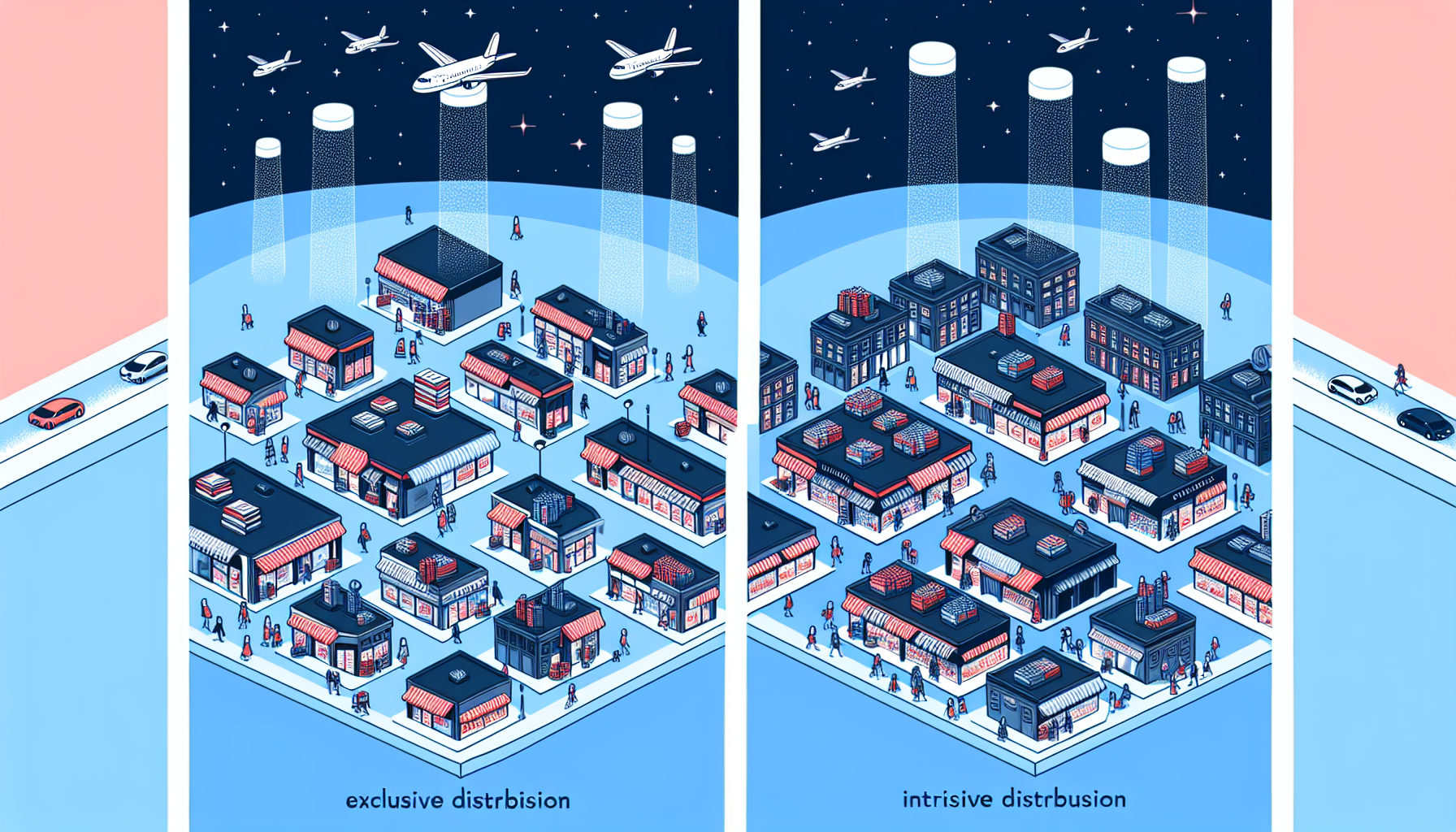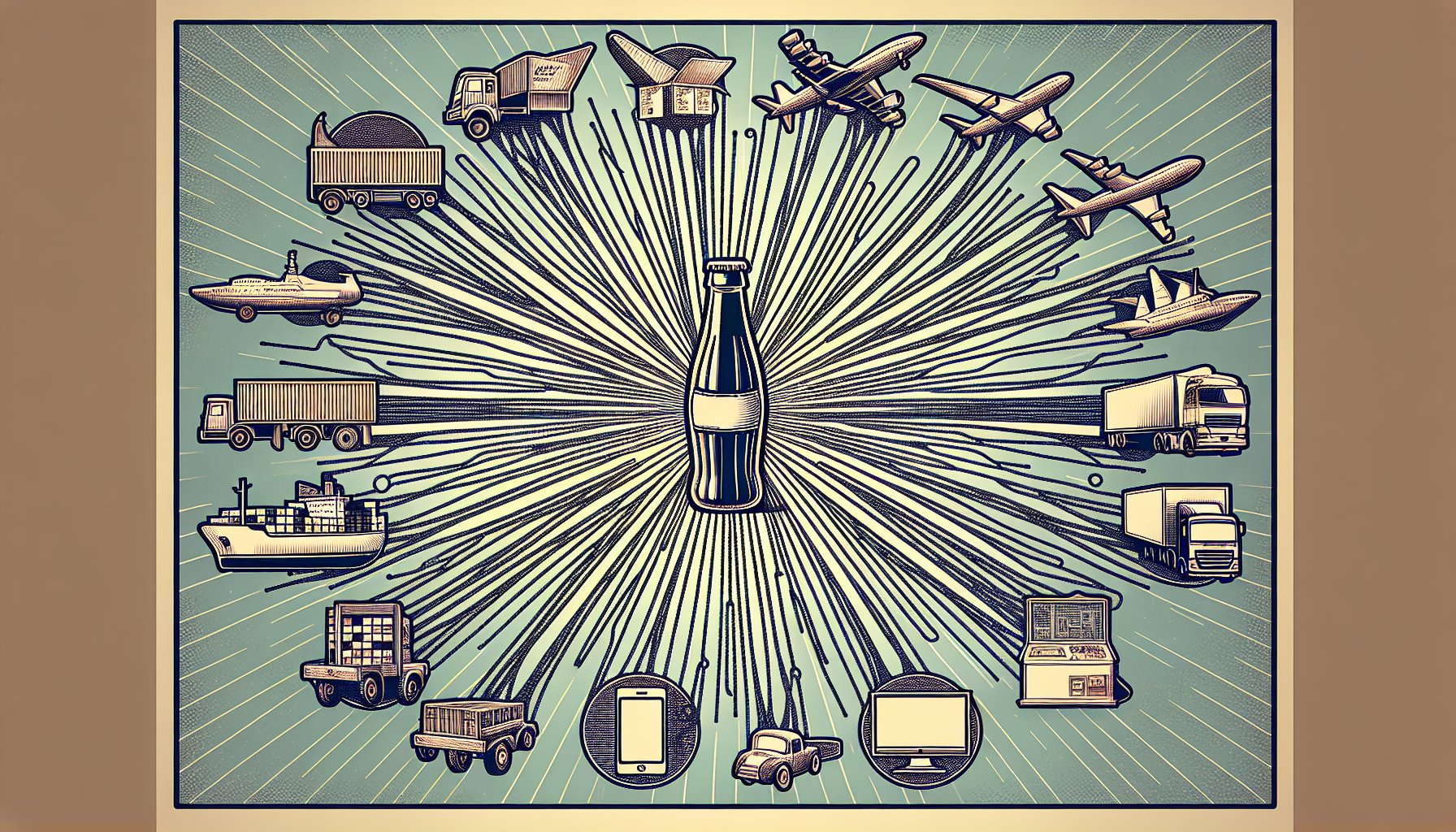Maximizing Sales: Innovative Distribution Strategy Insights for Modern Markets
A fundamental question is at the core of every business’s growth strategy: how do we efficiently deliver our products to consumers? The answer lies in choosing a robust distribution strategy. Efficiently navigating this decision can be the difference between leaving a strong market footprint or fading into the background. This guide explains why a distribution strategy matters and how it can drive your business to thrive—simply and straightforwardly.
Key Takeaways
- A distribution strategy is essential for revenue growth, customer loyalty, and effective market penetration, encompassing direct and indirect distribution channels to place products into consumers’ hands.
- There are three main distribution strategies: exclusive distribution to cultivate brand prestige, intensive distribution to maximize market coverage, and selective distribution to balance reach with reputation, each suited for different product types and market needs.
- Leveraging technology, particularly automation in logistics and the evolution of e-commerce, is critical for modernizing distribution strategies, and companies like Coca-Cola and Apple exemplify successful implementations of multi-channel and direct distribution strategies, respectively.
Decoding Distribution Strategy: The Backbone of Market Penetration

In marketing, distribution serves as a well-planned journey that a product or service takes from the producer to the final consumer. It’s like a proficient conductor who leads the products through different channels, guaranteeing their eventual availability for consumers.
An effectively implemented distribution strategy aims to:
- Boost revenue
- Cultivate customer loyalty
- Simplify processes
- Build a strong distribution network
- Form the bedrock for successful market penetration.
Essence of Distribution Channels
Consider distribution channels as the arteries of a business, carrying products from the company’s heart to the consumer’s bloodstream. These pathways can be direct or indirect, each with unique operational mechanisms. In direct distribution, producers sell directly to the consumer, eliminating intermediaries. On the other hand, indirect distribution strategies involve using middlemen such as distributors and retailers to get products into the hands of consumers.
You might question the roles these intermediaries perform. Let’s investigate. Retailers function as the points of sale where consumers access products. These retailers get their products from distributors or wholesalers. Then, we have brokers and agents who manage the logistics of the sales process. They handle contracts and marketing and coordinate specialized shipments. So, selecting distribution channels is like choosing the right arteries to ensure that the life-giving products reach the consumer body efficiently.
Crafting a Robust Distribution Network
Having grasped the essence of distribution channels, we can now examine the significance of establishing a sturdy distribution network. Like a well-built highway ensures efficient travel, a robust distribution network guarantees efficient product delivery and increased market presence. But who are the architects of this highway?
The architects of this highway are distributors and wholesalers. Distributors are the ones who make sure the products are effectively sold through retail channels. Think of them as the salespeople for the producers. On the other hand, wholesalers focus on storing and transporting goods, like the truck drivers on our distribution highway. They purchase in bulk from distributors or manufacturers, allowing for lower pricing. So, crafting a robust distribution network is like building an efficient highway system that ensures smooth and rapid travel of products.
Ready to take your distribution strategy to the next level?
Click here to book a 15-minute coffee chat with me and discover how executive coaching can enhance your business’s market reach.
Unveiling Types of Distribution Strategies

As we navigate the distribution path, we encounter three major roadsigns – intensive, exclusive, and selective. Each sign directs us to a unique distribution strategy tailored to meet specific business needs and market contexts. Let’s explore each of these routes.
Exclusive Distribution: Cultivating Brand Prestige
Imagine driving on a private road exclusive to only a select few. That’s what exclusive distribution feels like. It’s a strategy that exudes brand prestige by restricting a product’s availability to specific retailers or customer segments.
But what kinds of products ride this exclusive road? High-priced products with strong brand recognition, like Apple products, are perfect passengers for this route. This strategy not only drives up brand prestige but also generates scarcity, stimulating demand and creating a perception of exclusivity. However, like all roads, this one has its bumps and turns. While it offers higher profit margins and control over brand image, it also comes with the challenges of restricted market reach and reliance on distributors.
Intensive Distribution: Maximizing Market Coverage
Next, let’s embark on the journey of intensive distribution. Picture a wide, sprawling highway with multiple lanes and exits, reaching far and wide. That’s intensive distribution for you. This strategy ensures that products are accessible across a wide range of outlets, aiming to reach customers at their usual shopping spots, making it ideal for routine purchases.
The beauty of this strategy lies in its ability to enhance product visibility, improve consumer accessibility, and ensure comprehensive market coverage. Intensive distribution is all about being seen and available, making it the highway of choice for products aiming for maximum market coverage.
Selective Distribution: Balancing Reach and Reputation
Finally, let’s take a ride on the road of selective distribution. This strategy is the middle ground, the perfect balance between a private road’s exclusivity and a highway’s broad reach. By meticulously selecting retail partners that resonate with the intended customer base, selective distribution strikes a balance between wide-scale availability and preserving a perception of exclusivity.
This strategy is like having your cake and eating it, too. Businesses can target a specific audience seeking quality and brand reputation while avoiding excessive choices. It’s perfect for products falling within the moderate price range and subject to consumer comparison before purchase, like clothing and small appliances.
All in all, selective distribution is the route for those seeking a balance between reach and reputation.
Wondering which distribution strategy aligns best with your business goals?
Let’s discuss it over a coffee chat! Click here to schedule a 15-minute session and explore your options with a seasoned business coach.
Navigating Direct vs. Indirect Distribution Paths
The distribution world is a sprawling network of paths, each leading to unique destinations. Two of these paths are direct and indirect distribution, each offering different business advantages and challenges.
Let’s examine these paths and comprehend their distinctive characteristics.
The Direct Distribution Channel: Control and Customer Connection
We start by exploring the route of direct distribution. This path is akin to a straight road from the producer to the consumer, eliminating any roadblocks or detours in the form of intermediaries. Implementing a direct distribution strategy offers businesses increased control over distribution elements like pricing, marketing, and product delivery to customers.
Moreover, this direct connection enhances customer relationships. Companies can collaborate closely with customers, understand their requirements, and deliver superior products and services without any interference from intermediaries. By utilizing a direct channel, companies can also employ strategies such as training programs and project plans to manage the expenses linked to direct distribution. So, if you’re seeking control and direct customer connection, the direct distribution path is the route to take.
The Indirect Distribution Channel: Extending Market Reach
Now, we turn our attention to the journey of indirect distribution. Unlike the straight road of direct distribution, this path weaves through various intermediaries such as wholesalers and retailers, ultimately reaching the consumer. This extension of market reach allows businesses to tap into the expertise and resources of these intermediaries, making it more convenient for customers to access the products.
However, this path is not without its challenges. Businesses have to:
- Find a balance between indirect and direct distribution channels
- Ensure the delivery of unique customer experiences
- Manage effective distribution through these indirect channels
Therefore, if you want to extend your market reach, the indirect distribution path is the one to tread on.
Leveraging Technology in Modern Distribution Strategies
As we traverse the landscape of distribution strategies, it’s impossible to ignore the towering skyscrapers of technology that have emerged on the horizon. Modern distribution strategies now leverage this technology to catapult to new heights of efficiency and market reach.
Automation in Logistics Management

Automation is a primary technological advancement propelling modern distribution strategies. Just like a well-oiled machine, automation streamlines processes and reduces human error, enhancing overall efficiency in logistics management.
Automation in logistics and supply chain management is revolutionizing the industry by:
- Integrating automated systems like barcode scanning for inventory tracking
- Reducing manual tasks like data entry
- Expediting the flow of goods through robotics
- Streamlining storage tasks
- Monitoring inventory levels
Automation is like the fuel that powers the machine of modern distribution strategies.
E-Commerce Evolution: Online Shopping and Beyond
Now, let’s shift our focus to the realm of e-commerce. This digital marketplace has expanded distribution channels to include online shopping and mobile commerce, transforming the traditional distribution landscape.
The dawn of online shopping has prompted the need for enhanced distribution networks and optimized warehouse placement to reduce transit times and enhance the overall distribution process. Thus, the evolution of e-commerce is like a digital revolution, reshaping distribution strategies and propelling them into the future.
Embracing technology in distribution can be transformative.
Schedule a 15-minute coffee chat with me to learn how executive coaching can help you navigate these changes and drive business success. Click here!
Case Studies: Successful Distribution Strategies in Action

Having explored the terrain of distribution strategies, it’s time to garner insights from the real world.
We will examine two case studies of triumphant distribution strategies – Coca-Cola’s multi-channel method and Apple’s direct distribution edge.
Coca-Cola: Mastering Multiple Distribution Channels
Coca-Cola, the world-renowned beverage giant, is a shining example of a successful multi-channel distribution strategy. The company uses an indirect distribution model, focusing on selling products to:
- Bottling and canning operations
- Distributors
- Fountain wholesalers
- Some fountain retailers
Coca-Cola’s marketing strategy involves:
- A closely coordinated effort with its bottling operators to maintain the strength and consistency of its global brand through local channels
- Close collaboration with bottling operators to expand its global presence
- Fostering economic growth in local communities
- Ensuring global distribution of its products
This strategy allows Coca-Cola to maintain its global brand while supporting local communities and reaching customers worldwide.
Apple: The Direct Distribution Advantage
On the other hand, we have Apple, a tech titan that leverages direct distribution to maintain control over its products and create a sense of exclusivity. Apple’s distribution strategy encompasses a blend of direct and indirect channels, including their physical and online stores for direct distribution.
This direct connection comes with several advantages for Apple, such as control over customer experience, the ability to enhance its service business, and the opportunity to build its brand on a large scale. However, this path is not without its challenges, as Apple must balance indirect and direct distribution channels and ensure the effective distribution of its products and services through its direct channels.
Are you inspired by these success stories but unsure how to apply them to your business?
Click here for a 15-minute coffee chat to discuss personalized strategies for your business’s distribution challenges.
Crafting Your Optimal Distribution Plan

After venturing through the terrain of distribution strategies, it’s time to apply our garnered knowledge. We will learn how to formulate the best distribution plan by assessing product and market dynamics and pinpointing crucial distribution partners.
Evaluating Product and Market Dynamics
Crafting an optimal distribution plan is like charting a map for a successful journey. It begins with a thorough evaluation of product and market dynamics. Here are the crucial steps in this process:
- Understanding the characteristics of your target market
- Conducting a target market analysis
- Considering product characteristics
- Evaluating different distribution channels
By following these steps, you can create a well-informed distribution plan to help you effectively reach your target market.
Additionally, understanding market dynamics offers valuable insights into:
- transportation
- packaging
- delivery
- product assortment
- pricing
- promotions
- overall market strategies
So, evaluating product and market dynamics is like surveying the landscape before charting your path, ensuring a smooth and successful journey.
Identifying and Partnering with Key Distributors
Like every successful journey involves reliable companions, crafting an optimal distribution plan requires identifying and partnering with key distributors. Establishing agreements with key distributors is essential to ensure efficient product delivery and effective market penetration.
The relationship with distributors and intermediaries is a crucial aspect of this partnership. Fostering open communication and collaboration, creating value for each party through strategic partnerships, and consistently contributing to joint initiatives are all ways to collaborate with distributors effectively.
Thus, identifying and partnering with key distributors is like choosing reliable companions for your journey, ensuring a smooth and successful ride.
Ready to chart your path to distribution success?
Click here to book a 15-minute coffee chat with me, your expert business coach, and start navigating your business toward optimal distribution and market penetration.
Summary
We have traversed the landscape of distribution strategies, navigated direct and indirect distribution paths, leveraged technology, and learned from successful case studies. We’ve understood the essence of distribution channels, explored various distribution strategies, and learned how to craft an optimal distribution plan. The road to successful market penetration is paved with strategic choices, and an effective distribution strategy is one of the most crucial. So, are you ready to navigate your distribution journey?
Frequently Asked Questions
What is the distribution strategy?
A product distribution strategy outlines the process of getting products to their destination, including the when, where, and how. It is a fundamental aspect of product management.
What are the 4 types of channels of distribution?
The 4 types of channels of distribution are wholesalers, retailers, distributors, and the Internet. These channels can be direct, where the manufacturer sells to the consumer.
What are the elements of distribution strategy?
The main elements of a distribution strategy include selecting channels to reach the target market, activating those channels, and controlling the results. These elements are crucial for effectively reaching and serving the chosen market.
How does automation enhance logistics management?
Automation enhances logistics management by integrating automated systems for inventory tracking and stock level updates, reducing manual tasks and minimizing human intervention to optimize processes. This boosts efficiency and accuracy in logistics operations.
How has e-commerce transformed distribution strategies?
E-commerce has expanded distribution channels to include online shopping and mobile commerce, transforming the traditional distribution landscape. This has led to a shift in consumer behaviour and expectations.



